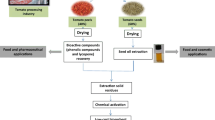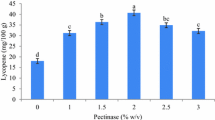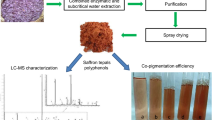Abstract
The opportunity of tomato peel waste exploitation for simultaneous recoveries of high value compounds, such as pectin, polyphenols and fatty acids (FAs) is presented in this work. Prior to polyphenols and FAs extraction, the pectin removed from tomato cuticle was evaluated as possible tin corrosion inhibitor using electrochemical impedance spectroscopy. Subsequently, de-pectinized tomato peels are evaluated as appropriate bio-substrate for polyphenols and FAs recovery, using chromatographic analyses. Corrosion tests (24 h) showed that pectin (4 g/L) isolated from tomato peel act as more efficient tin corrosion inhibitor (η = 65.8%) than commercial apple pectin (η = 52.3%), which points out that it could be used as natural corrosion inhibitor. The polyphenols data showed that de-pectinized samples contained higher amounts of total phenols (2485.68–4064.46 mg/100 g, in 96% ethanol) and chlorogenic acid derivative (86.13–454.34 109 mg/100 g, in 70% ethanol) than samples with pectin incorporated in tomato cuticle. In addition, de-pectinized samples contained more polyunsaturated FAs (~ 45%) than samples with pectin (~ 26). Furthermore, both types of peels contained linoleic, palmitic and oleic acids as three dominants, and thus represented valuable source of nutritive oils. Their presence was also confirmed by FTIR and NMR spectroscopy. Therefore, obtained findings revealed that already exploited tomato peel for pectin production could be effectively re-used for polyphenols and FAs recoveries, providing valuable benefits, either for producers and consumers, such as decreasing the waste disposal costs and take opportunity that isolated compounds could be reintroduced into food.
Graphic Abstract








Similar content being viewed by others
References
Fritsch, C., Staebler, A., Happel, A., Cubero Márquez, M.A., Aguiló-Aguayo, I., Abadias, M., Gallur, M., Cigognini, I.M., Montanari, A., López, M.J., Suárez-Estrella, F., Brunton, N., Luengo, E., Sisti, L., Ferri, M.: Processing, valorization and application of bio-waste derived compounds from potato, tomato, olive and cereals: a review. Sustainability. 9, 1–46 (2017)
Kalogeropoulos, N., Chiou, A., Pyriochou, V., Peristeraki, A., Karathanos, V.T.: Bioactive phytochemicals in industrial tomatoes and their processing by-products. LWT-Food Sci. Technol. 49, 213–216 (2012)
Kaur, D., Wani, A.A., Oberoi, D.P.S., Sogi, D.S.: Effect of extraction conditions on lycopen extractions from tomato processing waste skin using response surface methodology. Food Chem. 108, 711–718 (2008)
Lavelli, V., Scarafoni, A.: Effect of water activity on lycopen and flavonoid degradation in dehydrated tomato skins fortified with green tea extract. J. Food Eng. 110, 225–231 (2012)
Navarro-González, I., García-Valverde, V., García-Alonso, M., Periago, M.J.: Chemical profile, functional and antioxidant properties of tomato peel fiber. Food Res. Int. 44, 1528–1535 (2011)
Rizk, E.M., El-Kady, A.T., El-Bialy, A.R.: Characterization of carotenoids (lyco-red) extracted from tomato peels and its uses as natural colorants and antioxidants of ice cream. Ann. Agric. Sci. 59, 53–61 (2014)
Sakar, A., Kaul, P.: Evaluation of tomato processing by-products: a comparative study in a pilot scale setup. J. Food Process Eng. 37, 299–307 (2014)
Vallverdú-Queralt, A., Medina-Remón, A., Casals-Ribes, I., Andres-Lacueva, C., Waterhouse, A.L., Lamuela-Raventos, R.M.: Effect of tomato industrial processing on phenolic profile and hydrophilic antioxidant capacity. LWT-Food Sci. Technol. 47, 154–160 (2012)
Valta, K., Damala, P., Panaretou, V., Orli, E., Moustakas, K., Loizidou, M.: Review and assessment of waste and wastewater treatment from fruits and vegetables processing industries in Greece. Waste Biomass Valor. 8, 1629–1648 (2017)
Balasundram, N., Sundram, K., Samman, S.: Phenolic compounds in plants and agri-industrial by-products: antioxidant activity, occurrence, and potential uses. Food Chem. 99, 191–203 (2006)
Nour, V., Panaite, T.D., Ropota, M., Turcu, R., Trandafir, I., Corbu, A.R.: Nutritional and bioactive compounds in dried tomato processing waste. CyTA J. Food. 16, 222–229 (2018)
Pinela, J., Prieto, M.A., Barreiro, M.F., Carvalho, A.M., Oliveira, M.B.P.P., Curran, T.P., Ferreira, I.C.F.R.: Valorisation of tomato wastes for development of nutrient-rich antioxidant ingredients: a sustainable approach towards the needs of the today's society. Innov. Food Sci. Emerg. Technol. 41, 160–171 (2017)
Toor, R.K., Savage, G.P.: Antioxidant activity in different fractions of tomatoes. Food Res. Int. 38, 487–494 (2005)
Arabani, A.A., Hosseini, F., Abbaspour, F., Anarjan, N.: The effect of ultrasound pre-treatment process on oil extraction from tomato waste. Int. J. Biosci. 4, 8–15 (2015)
Botinestean, C., Gruia, A.T., Jianu, I.: Utilization of seeds from tomato processing wastes as raw material for oil production. J. Mater. Cycles Waste Manag. 17, 118–124 (2015)
Demirbas, A.: Oil, micronutrient and heavy metal contents of tomatoes. Food Chem. 118, 504–507 (2010)
Elbadrawy, E., Sello, A.: Evaluation of nutritional value and antioxidant activity of tomato peel extracts. Arab. J. Chem 9, S1010–S1018 (2016)
Gharbi, S., Renda, L., La Barbera, M., Amri, M., Messina, C.M., Santulli, A.: Tunisian tomato by-products, as a potential source of natural bioactive compounds. Nat. Prod. Res. 31, 626–631 (2017)
Isik, F., Yapar, A.: Fatty acid composition and sensory properties of tarhanas prepared by processed tomato and paprika waste material. J. Food Process. Preserv. 38, 607–614 (2012)
Benatti, P., Peluso, G., Nicolai, R., Calvani, M.: Polyunsaturated fatty acids: biochemical, nutritional and epigenetic properties. J. Am. Coll. Nutr. 23, 281–302 (2004)
Ninčević Grassino, A., Halambek, J., Djaković, S., Rimac Brnčić, S., Dent, M., Grabarić, Z.: Utilization of tomato peel waste from canning factory as a potential source for pectin production and application as tin corrosion inhibitor. Food Hydrocoll. 52, 265–274 (2016)
Ninčević Grassino, A., Brnčić, M., Vikić-Topić, D., Roca, S., Dent, M., Rimac Brnčić, S.: Ultrasound assisted extraction and characterization of pectin from tomato waste. Food Chem. 198, 93–100 (2016)
Marić, M., Ninčević Grassino, A., Zhu, Z., Barba, F.J., Brnčić, M., Rimac-Brnčič, S.: An overview of the traditional and innovative approaches for pectin extraction from plant food wastes and by-products: Ultrasound-, microwaves-, and enzyme-assisted extraction. Trends Food Sci. Technol. 76, 28–37 (2018)
Ninčević Grassino, A., Barba, F.J., Brnčić, M., Lorenzo, J.M., Lucini, L., Rimac-Brnčič, S.: Analytical tools used for the identification and quantification of pectin extracted from plant food matrices, wastes and by-products: a review. Food Chem. 266, 47–55 (2018)
Parniakov, O., Barba, F.J., Grimi, N., Lebovka, N., Vorobiev, E.: Extraction assisted by pulsed electric energy as a potential tool for green and sustainable recovery of nutritionally valuable compounds from mango peels. Food Chem. 192, 842–848 (2016)
Fares, M.M., Maayta, A.K., Al-Qudah, M.M.: Pectin as promising green corrosion inhibitor of aluminium in hydrochloric acid solution. Corros. Sci. 60, 112–117 (2012)
Fioro-Bimbi, M., Alvarez, P.E., Vaca, H., Gervasi, C.A.: Corrosion inhibition of mild steel in HCl solution by pectin. Corros. Sci. 92, 192–199 (2015)
Spanos, G.A., Wrolstad, R.E.: Influence of processing and storage on the phenolic composition of Thompson seedless grape juice. J. Agric. Food Chem. 38, 1565–1571 (1990)
Zhishen, J., Mengcheng, T., Jianming, W.: The determination of flavonoid contents in mulberry and their scavenging effects on superoxide radicals. Food Chem. 64, 555–559 (1999)
Barros, L., Dueñas, M., Carvalho, A.M., Ferreira, I.C.F.R., Santos-Buelga, C.: Characterization of phenolic phenolic compounds in flowers of wild medicinal plants from Northeastern Portugal. Food Chem. Toxicol. 50, 1576–1582 (2012)
Petrović, M., Kezić, N., Bolanča, V.: Optimization of the GC method for routine analysis of the fatty acid profile in several food samples. Food Chem. 122, 285–291 (2010)
Blunden, S., Wallace, T.: Tin in canned food: a review and understanding of occurrence and effect. Food Chem. Toxicol. 41, 1651–1662 (2003)
Ninčević Grassino, A.: Plant extracts as a natural corrosion inhibitors of metals and its alloys used in food preserving industry. In: Méndez-Vilas, A. (ed.) Science within food: up to date advances on research and education ideas, food science book series, pp. 185–193. Formatex Research Center, Badajoz (2017)
Metikoš-Huković, M., Kwokal, A., Piljac, J.: The influence of niobium and vanadium on passivity of titanium-based implants in physiological solution. Biomaterials 24, 3765–3775 (2003)
Bonilla, S.H., Rodriguez, J., Zinola, C.F., Bello, C., Giannetti, B.F.: Film formation and surface growth on tin electrodes in bicarbonate solutions: an impedance spectroscopy study. Corros. Sci. 47, 835–848 (2005)
Domínguez, E., Heredia-Guerrero, J.A., Heredia, A.: The biophysical design of plant cuticles: an overview. New Phytol. 189, 938–949 (2011)
Aires, A., Carvalho, R., Saavedra, M.J.: Reuse potential of vegetable wastes (broccoli, green bean and tomato) for the recovery of antioxidant phenolic acids and flavonoids. Int. J. Food Sci. Technol. 52, 98–107 (2017)
Ćetković, G., Savatović, S., Čanadović-Brunet, J., Djilas, S., Vulić, J., Mandić, A., Četojević-Simin, D.: Valorisation of phenolic composition, antioxidant and cell growth activities of tomato waste. Food Chem. 133, 938–945 (2012)
Lavelli, V., Torresani, M.C.: Modelling the stability of lycopene-rich by-products of tomato processing. Food Chem. 125, 529–535 (2011)
Perea-Domínguez, X.P., Hernández-Gastelum, L.Z., Olivas-Olguin, H.R., Espinosa-Alonso, L.G., Valdez-Morales, M., Medina-Godo, S.: Phenolic composition of tomato varieties and an industrial tomato by-product: free, conjugated and bound phenolics an antioxidant activity. J. Food Sci. Technol. 55, 3453–3461 (2018)
da Silva, A.C., Jorge, N.: Bioactive compounds of oils extracted from fruits seeds obtained from agroindustrial waste. Eur. J. Lipid Sci. Technol. 119, 1600024 (1–5) (2017)
Chen, E.C.Y., Ismail, A.A., Sedman, J., van de Voort, F.R.: Vibrational Spectroscopy of Food and Food Products. In: Chalmers, J.M., Griffiths, P.R. (eds.) Handbook of Vibrational Spectroscopy, pp. 3629–3662. Wiley, Chichester (2002)
Funding
This study was funded by Croatian Ministry of Science, Education and Sports (Grant No. 058-0580000-3071).
Author information
Authors and Affiliations
Corresponding author
Ethics declarations
Conflict of interest
The authors declare that they have no conflict of interest.
Additional information
Publisher's Note
Springer Nature remains neutral with regard to jurisdictional claims in published maps and institutional affiliations.
Rights and permissions
About this article
Cite this article
Ninčević Grassino, A., Djaković, S., Bosiljkov, T. et al. Valorisation of Tomato Peel Waste as a Sustainable Source for Pectin, Polyphenols and Fatty Acids Recovery Using Sequential Extraction. Waste Biomass Valor 11, 4593–4611 (2020). https://doi.org/10.1007/s12649-019-00814-7
Received:
Accepted:
Published:
Issue Date:
DOI: https://doi.org/10.1007/s12649-019-00814-7




